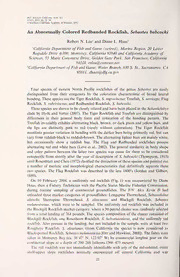
An Abnormally Colored Redbanded Rockfish, Sebastes babcocki PDF
Preview An Abnormally Colored Redbanded Rockfish, Sebastes babcocki
Bull SouthernCaliforniaAcad. Sci. 111(1),2012,pp.22-24 ©SouthernCaliforniaAcademyofSciences.2012 An Abnormally Colored Redbanded Rockfish, Sehastes habcocki Robert N. Lea' and Diane L. Haas- ^California Department ofFish and Game (retired), Marine Region, 20 Lower Ragsdale Drive ij^lOO, Monterey, California 93940 and California Academy of Sciences, 55 Music Concourse Drive, Golden Gate Park, San Francisco, California 94118. [email protected] -California Department ofFish andGame, Water Branch, 830 S. St., Sacramento, CA 95811 [email protected] . Four species of eastern North Pacific rockfishes of the genus Sebastes are easily distinguished from their congeners by the coloration characteristic of broad lateral banding. These species are the Tiger Rockfish, S. nigrocinctus; Treefish, S. serriceps; Flag Rockfish, S. rubrivinctus; and Redbanded Rockfish, S. babcocki. These species are shown to be closely related and have been placed in the Sebastichthys clade by Hyde and Vetter (2007). The Tiger Rockfish and Treefish are distinguished by differences in their general body form and coloration of the banding pattern. The Treefish invariably exhibits alternating black, brown, or dark green and yellow bars, and the lips are distinctly pink to red (rarely without coloration). The Tiger Rockfish manifests greater variation in banding with the darker bars being primarily red, but can vary from reddish-black to reddish-brown. The alternating lighter bars are mainly white, but occasionally show a reddish hue. The Flag and Redbanded rockfishes possess alternating red and white bars (Love et al., 2002). The general similarity in body shape and color pattern between the latter two species was cause for them to be considered conspecific from shortly after the year of description of S. babcocki (Thompson, 1915) until Rosenblatt and Chen (1972) clarified the distinction ofthese species andpointed out a number of meristic and morphological characteristics that definitively separate these two species. The Flag Rockfish was described in the late 1800's (Jordan and Gilbert, 1880). On 10 February 2004, a uniformly red rockfish (Fig. 1) was encountered by Diane Haas, then a Fishery Technician with the Pacific States Marine Fisheries Commission, during routine sampling of commercial groundfishes. The F/V Alex Kevin D had unloaded three market categories ofgroundfishes: Longspine Thornyhead, Sebastolobus altirelis; Shortspine Thornyhead, S. cdascamis\ and Blackgill Rockfish, Sebastes mekinostomus, which were to be sampled. The uniformly red rockfish was included in the Blackgill Rockfish market category, where a 50 pound cluster was randomly selected from a total landing of 764 pounds. The species composition ofthe cluster consisted of Blackgill Rockfish, one Rosethorn Rockfish, S. helvomaculatus, and the uniformly red rockfish. Also present in the landing, but not included in the sample, were at least two Rougheye Rockfish, S. aleutiauus, (from California the species is now considered as Blackspotted Rockfish, Sebastesmekmostictus [Orr and Hawkins, 2008]). The fishes were taken in Monterey Bay (ca. 36 47' N, 122 07' W) by commercial longline gear on the continental slope at a depth of 200-260 fathoms (366^75 meters). The red rockfish was not immediately identifiable with any of the red-colored, outer shelf-upper slope rockfishes normally encountered off central California and was 22 ABNORMALLY COLORED ROCKFISH 23 Figure 1. Uniformlyred RedbandedRockfish, Sebastesbabcocki, from MontereyBay, sampledfrom FA^ Alex Kevin D. 10 February 2004. procured for further analysis in the laboratory. Upon examination of the general morphology ofthe specimen, wedetermined it to be a Redbanded Rockfish, typical in all aspects ofS. babcockiwith the exception ofcoloration (i.e.. essentially uniformly red and mm mm lackingvertical red and white banding). The rockfish measured 557 TL, 546 FL, mm and 465 SL. and weighed 2564.0 g when fresh. The fish was a mature male and possessed a large genital papilla. Counts were: D XIII, 14; A III, 7; Pectoral L 9/18, R 8/18 (unbranched rays/total rays); Gill rakers L 9+22=31, R 8+21=29. The age was estimated to be 57 years from otoHths using the break and burn method (D. Pearson, NOAA, NMFS, pers. comm.). The general morphology of the preopercular bone was typical for the species; the third spine is acutely hooked downward in S. babcocki Figure 2. General morphology ofpreopercular bone from Redbanded Rockfish. Sebastes babcocki: note configuration of3'"'^ preopercular spine. Bone from specimen (548 mm SL. 655 mm TL) taken off Davenport, Calif, 170-215 fm.. F/V Sunrise III set gill net. 5 April 1995. 24 SOUTHERN CALIFORNIA ACADEMY OF SCIENCES (Fig. 2), a condition we know ofin only one other species, the Semaphore Rockfish, S. inekmosema. Correct identification ofany fish species is extremely important due to the implications itmayhavein fisheriesmanagement. The speciescompositionsdeterminedduringroutine sampling ofmarket categories are used to estimate total landings ofcomponent species. These estimates, along with biological information collected with each species, such as length and age composition, are utilized in stock assessments. Because individual species often have different quotas and fishing regulations, accurate identification is critical to the regulatory process. For instance, a number of red-colored rockfishes fall under the category ofshelfrockfishes while Redbanded Rockfish is categorized as a slope species. The misidentification ofa quota-managed species could result in delayed fishery closures (Faunce, 2011). Acknowledgements We thank the crew ofthe F/V Alex Kevin D for the anomalously colored rockfish {S. babcocki), Don Pearson for ageing the specimen, and Donna Khne for providing useful comments. References Faunce. C.H. 2011. A comparison between industry and observercatch compositions within the Gulfof Alaska rockfish fishery. ICES Journal ofMarine Science. doi:10.1093/icesjms/fsr093. Hyde. J.R. and R.D. Vetter. 2007. The origin, evolution, and diversification ofrockfishes ofthe genus Sebastes (Cuvier). Molecular Phylogenetics and Evolution, 44(2): 790-811. Jordan, D.S. andC.H. Gilbert. 1880. Description ofsevennewspecies ofsebastoidfishes, fromthecoast ofCalifornia. Proceedings ofthe United States National Museum, 3(150): 287-298. Love.M.S.,M.Yoklavich,andL.Thorsteinson.2002.TheRockfishesofthenortheastPacific.University ofCalifornia Press. 405 pp. Orr. J.W. and S. Hawkins. 2008. Species of the rougheye rockfish complex: resurrection of Sebastes mekmostictus(Matsubara, 1934)andaredescriptionofSebastesakutiamis(JordanandEvermann, 1898) (Teleostei: Scorpaeniformes). Fishery Bulletin, 106(2): 111-134. Rosenblatt. R.H.. and L.-C Chen. 1972. The identity of Sebastes babcocki and Sebastes nibrivinctiis. California Fish and Game, 58(1): 32-36. Thompson. W.F. 1915. Anew fish ofthegenus Sebastodesfrom British Columbia, withnotes on others. Report ofthe Commissioner ofFisheries for British Columbia, 1914:120-122.
